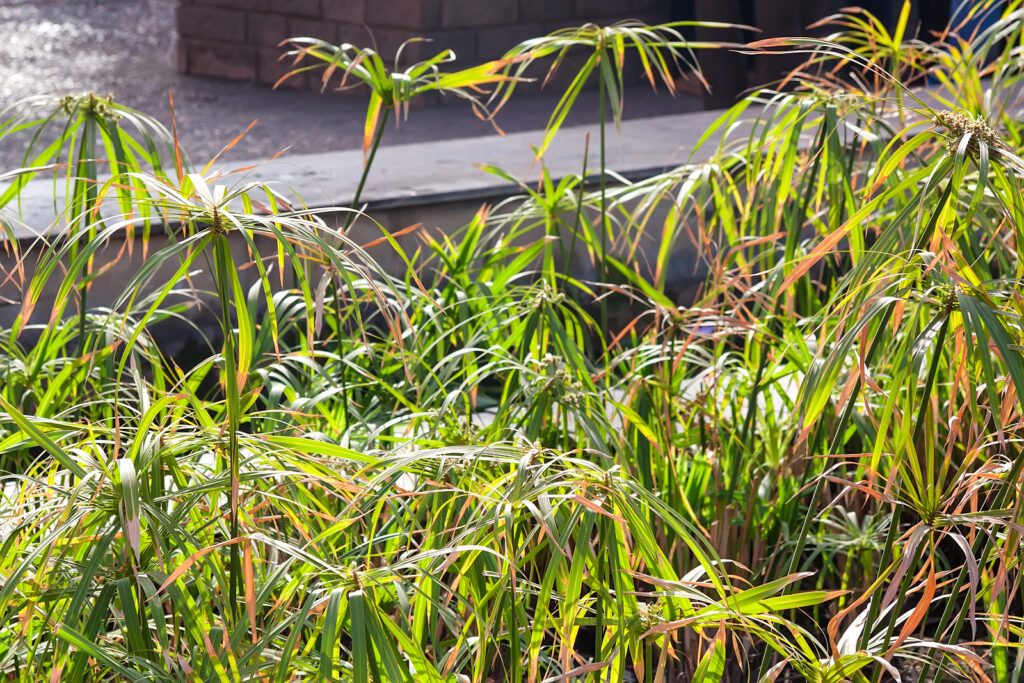Cyperus–commonly called umbrella plant or papyrus–is a sedge, a grasslike plant that is different than a true grass; it has three-angled solid stems. Cyperus are known for their striking form, silhouette, and shadow patterns. Cyperus bears grasslike flower heads.
Cyperus can be grown in moist soil with its roots submerged in water. It can be grown in full sun or shade. Cyperus is a good choice for a water garden, bog planting, or rock garden. It grows in or out of water.
Cyperus can be potted up and grown indoors in cold winter regions. It can be grown in an aquarium or a soil-filled tub. Cyperus can be a vigorous grower; it is easily divided when it becomes too large.
Cyperus is a genus of more than 500 species of sedge or grass-like perennials. Cyperus is native to wet habitats throughout tropical and subtropical regions of the world. Some can be found in cool temperate regions.
Get to know Cyperus
- Plant type: Perennial sedge
- Growing zones and range: Zones 10-11
- Hardiness: Tender
- Optimal growing temperature: day, 68° to 72°F (20° to 22°C); night, 55° to 68°F (13° to 20°C).
- Height and width: 3 to 4 feet (0.9 to 1.2 m) tall and about 12 to 16 inches (30-40cm) wide.
- Foliage: Cylindrical, 3-angled leafy stems are linear
- Flowers: Flowers spikelets take on an umbrella-like form at top of leaf stalks.
- Bloom time: Summer
- Uses: water gardens, pond margins, rock gardens
- Common name: Umbrella plant
- Botanical name: Cycas
- Family name: Cyperaceae
- Origin: Wet habitats throughout tropical and subtropical regions of the world

Where to plant Cyperus
- Light outdoors: Plant Cyperus in sun or partial shade.
- Light indoors: Give Cyperus bright light from eastern or western exposure, with direct sun in winter. Does well under artificial light, needing 14 light-hours daily.
- Soil outdoors: Grow Cyperus in moist soil or as a marginal plant in 6 to 12 inches (15-30cm) of water
- Soil indoors: Grow Cyperus in an all-purpose mix.
When to plant Cyperus
- Set Cyperus outdoors in spring.
Planting and spacing Cyperus
- Space Cyperus 12 to 16 inches (30-40cm) apart.
How to water and feed Cyperus
- Water: Keep thoroughly wet, not soggy. Mist frequently. Humidity, 45% to 60%. This is one plant that is nearly impossible to overwater; the soil should be kept moist, and the plant is suitable for growing in a water garden or an aquarium.
- Feeding: Fertilize Cyperus every 2 weeks during growing season, with mild liquid fertilizer. Fertilizer should be applied once a month in spring and summer.
Cyperus care
- The stems can be cut back to the roots if the plant begins to look shabby; new foliage will grow from the roots.
- Cyperus rests from fall through early spring. Keep soil barely moist; withhold fertilizer.
Growing Cyperus as a houseplant
- Cyperus grows best in bright to direct light all year long.
- Cyperus grows best at an average room temperature and high humidity.
- Keep the soil moist. Cyperus can be grown in a water garden or aquarium.
- Fertilize Cyperus once a month in spring and summer.
Cyperus pests and diseases
- Cyperus is susceptible to damage from mealybugs, scale insects, spider mites and whiteflies.
Cyperus propagation
- Propagae Cyperus by division or stem cutting. Float cuttings in water; when plantlets sprout, plant each in moist sand for rooting.
Cyperus varieties to grow
- Cyperus alternifolius, umbrella plant. Tufted perennial with grows 2 to 4 feet tall with arching green leaves which radiate from the ends of stems like umbrella ribs; topped withumbels of yellow-grown flowers from summer to autumn.
- C. papyrus, Egyptian paper. Grows to 8 feet (2.4m) tall; dark green, triangular stems bear a few leaves on top with tufts of threadlike growths on which small flowers may appear.















